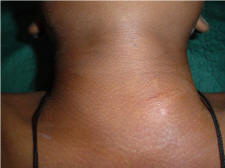Pendred Syndrome
Danielle Mercer1, Fern Tsien2, and Barbara Gordon-Wendt1
1 Department of Communication Disorders, LSUHSC School of Allied Health Professions
2 Department of Genetics, LSUHSC School of Medicine
Exact incidence of Pendred syndrome is unknown, but it is estimated to affect about 1 in 15,000. Pendred syndrome is characterized by severe to profound sensorineural hearing loss, vestibular aqueduct dilation, and thyroid goiter. The hearing loss is typically present at birth, and may progress in stages. The vestibule is the area in the inner ear responsible for balance. The vestibular aqueduct is a tunnel that maintains fluid balance in the inner ear. In those with Pendred syndrome, the vestibular aqueduct can be enlarged, leading to the inner ear fluids to be out of proportion. This causes balance problems in some patients. A goiter is an enlargement of the thyroid gland, which is seen as a mass in the front of the neck. The cochlea in Pendred syndrome patients is not completely formed. The cochlea is the sensory organ for hearing, located in the inner ear. It is normally curled in 2 ½ turns, but in those with Pendred syndrome, the cochlea may only contain 1 ½ turns. The gene causing Pendred syndrome accounts for about 5 to 10% of hereditary deafness. It is inherited in an autosomal recessive pattern.
Pendred syndrome major signs and symptoms:
- sensorineural hearing loss
- enlarged vestibular aqueduct
- goiter (enlarged thyroid gland)
- possible balance problems
For more information on Pendred syndrome, visit the following links:
http://www.nidcd.nih.gov/health/hearing/pages/pendred.aspx
http://ghr.nlm.nih.gov/condition/pendred-syndrome
For more information on enlarged vestibular aqueduct, visit the following link:
http://vestibular.org/enlarged-vestibular-aqueduct-syndrome-evas
For information on patient support for Pendred syndrome, visit the following links:
http://www.mdjunction.com/goiter

Thyroid goiter
From http://www.waent.org/archives/2009/vol2-1/thyroid-nodules/thyroid-nodules.htm
